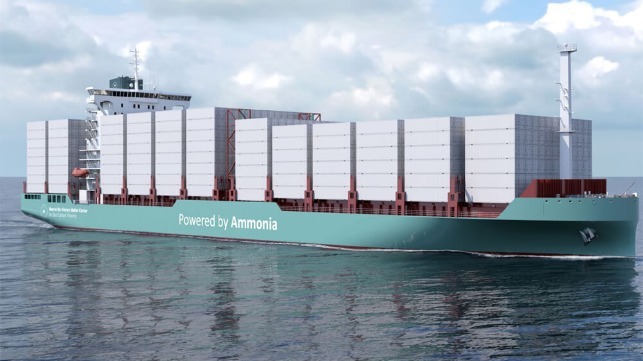Ammonia-Fueled Containership Design Marks Milestone with Two AiP Awards

Designs for a 3,500 TEU ammonia-fueled containership received the first stage Approval in Principle marking a milestone for the application of ammonia as an alternative marine fuel. The project, which involves an industry task force led by the Maersk Mc-Kinney Moller Center for Zero Carbon Shipping, collaborated on the key challenges of safety for both seafarers and port communities.
The project is the latest in a series of steps being taken to address the challenges of ammonia as a marine fuel. Previous collaborations included a quantitative risk assessment for ammonia ship design. The toxic nature of ammonia is a key challenge, as well as density and power components, are hurdles in the broad adoption of ammonia as a marine fuel.
The design concept presented is for a vessel 695 feet (212 meters) in length. The task force includes A. P. Moller-Maersk, MAN Energy Solutions, Deltamarin, Eltronic FuelTech, ABS, and LR, which detailed a concept for a vessel with a 4,300 cbm ammonia tank. It would be powered by an 18.5 MW main engine, have 5.8 MW auxiliary engines, and a shaft generator to provide 2 MW.
After a thorough review of the concept, two classification societies, ABS and Lloyd’s Register, awarded the AiP. ABS and LR provided safety and statutory standard expertise throughout the design and risk assessment process. While it is not regulatory approval, which will be issued by flag state administrations, the task force views this as a key step in the efforts.
“The fact that we have both ABS and LR granting this AiP in parallel is a testimony to the robustness of the design and the iterative risk assessment and systematic risk management intelligence that has gone into it,” said Claus W. Graugaard, Chief Technology Officer, Onboard Vessel Solutions at the Mærsk Mc-Kinney Møller Center for Zero Carbon Shipping. “The AiP of the new ship design is a major milestone on this journey as it demonstrates that safety criteria for the application of ammonia as the main fuel is within tolerable levels of industry safety management practices.”
The design outlines what the task force believes is a commercially viable and safe ammonia-fueled 3,500 TEU container feeder. They noted that in this phase the focus was on achieving an adequate level of safety for the crew, and at the same time minimizing loss of cargo capacity.
The ammonia tank capacity (4,000 cbm) was selected for a full roundtrip of relevant trades for this vessel. A. P. Moller Maersk contributed with its experience on the ship design part, while MAN Energy Solutions provided engine manufacturer/supplier expertise as the vessel would feature the first commercially available ammonia engine.
The detailed concept design was created by the ship design house Deltamarin, and the detailed fuel system supplier by Eltronic FuelTech. Two flag states, the Danish Maritime Authority and the Maritime and Ports Authority of Singapore, also participated in the project’s risk assessments.
In the next phase of the project, the Center will continue to lead the effort for the design. They will also be involving a charterer and ship owner.

that matters most
Get the latest maritime news delivered to your inbox daily.
It is one of several efforts working to overcome the challenges of ammonia as a marine fuel for container shipping. Last year, the Maersk Mc-Kinney Moller Center working with ship owner Seaspan presented early concepts for a 15,000 TEU vessel. Separately, Ocean Network Express working with Nihon Shipyard and classification society DNV launched a design effort in 2022. This project also received an AiP approval, from DNV, in January 2024 for a 3,500 TEU ammonia dual-fuel containership.
Australia’s Fortescue began testing earlier this year on an offshore service vessel converted to use ammonia. At the same time, major engine manufacturers including Wartsila and MAN reported strong progress in their designs and design efforts while a Japanese group reported it had developed an ammonia fuel supply system. The goal is to have the technology commercially available in one to two years.
